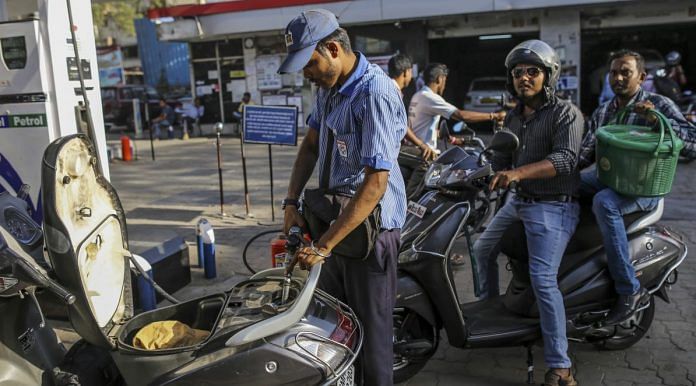The NITI Aayog vice chairman says the government must speak to BJP chief ministers as his organisation has no more leverage with the states for a cut in oil
New Delhi: The Modi government has the space to cut oil prices but it must first bite the bullet and speak to all the BJP-ruled states, NITI Aayog vice chairman Rajiv Kumar said.
In an exclusive interview with ThePrint, Kumar said the time has come for the “BJP political leadership” to speak to its own chief ministers to cut taxes and set an example for the rest of the country. States had earned windfall gains due to the rise of international oil prices.
He pointed out that NITI Aayog has no more leverage with the states in this regard.
“Yes, the states are refusing to cut taxes. They need to be convinced to do so. But convincing can only happen after communication. There is no other way. We don’t have leverage. After all, over 20 of them are ruled by the same party so they could be brought to one platform,” Kumar said.
As the debate over oil prices snowballs, it seems as if the NITI Aayog and the government are speaking in different voices.
GST on petrol and diesel
Dharmendra Pradhan, minister of petroleum and natural gas, said last week it is only a matter of time before petrol and diesel are included under GST. Since petrol and diesel are not under GST, oil companies cannot avail input credit causing losses worth Rs 20,000 crore annually, he added.
But Kumar strongly rejected the government’s idea of applying GST on petrol and diesel in the near future.
“Bringing it under GST, like I read a statement from the oil minister, the rate would be sky-high. The total tax on fuel or petroleum would be about 90 per cent,” said Kumar.
While bringing fuel under GST is the ultimate aim, if a 90 per cent tax needs to be avoided, it should be done in a sequential manner and not immediately, said Kumar.
Role of states
Taxes on oil across the country have skyrocketed since the rise in international prices. States have a percentage-based tax on oil – ranging from 11 to 37 per cent, said Kumar. Having pocketed higher revenues since the price rise, states are reluctant to slash the tax rates.
Kumar suggested a 15 to 20 per cent band for taxing oil that all states must comply with.
RBI rate hike
Kumar cautioned the RBI against taking any more steps to respond to inflationary expectations after the monetary policy review last week where it had hiked the repo rate.
RBI’s rate hike was largely directed towards perception management as India had begun to look weak on its macroeconomic parameters, said Kumar, at variance from an earlier position. He had expressed concerns over a possible overreaction from RBI.
“Unavoidable. At this time, unavoidable because of the $12 increase in oil price which kind of spooked everybody. And made it appear that India may become fragile once again in macroeconomic terms,” he said.
Kumar explained that headline inflation has not been a worry and core inflation, which does not include food and fuel items, is high because of housing which is transitory. Despite this, inaction from RBI would have sent the wrong message.
“If you hadn’t done it now, you would have in some sense strengthened the fears — right or wrong. But this is the market perception. And perceptions are important,” he added.
Commercial banks
The rate hike won’t have an impact on retail lending or growth, said Kumar. He hoped that commercial banks absorb some of the increase instead of passing it on to the consumers, which could make home loans more expensive.
He further explained that banks still have the capacity to increase lending. “Their (banks) lending is not at the highest level and they are holding a lot of government security. Each bank is holding higher SLR (statutory liquidity ratio) that it is required to be held. 19 per cent is what they are required and they are probably holding 25-26 per cent,” Kumar added.
SLR is the portion of deposits that commercial banks need to maintain in the form of gold, cash reserves and government securities before it lends to consumers. A higher SLR thus leaves lesser room for the banks’ lending activities.



